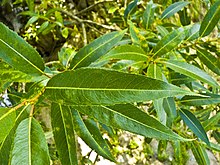Crack willow
| Salix fragilis | |
|---|---|
 |
|
| Leaves | |
| Scientific classification | |
| Kingdom: | Plantae |
| (unranked): | Angiosperms |
| (unranked): | Eudicots |
| (unranked): | Rosids |
| Order: | Malpighiales |
| Family: | Salicaceae |
| Genus: | Salix |
| Species: | S. fragilis |
| Binomial name | |
|
Salix fragilis L. |
|
Salix fragilis, with the common names crack willow and brittle willow, is a species of willow native to Europe and Western Asia. It is native to riparian habitats, usually found growing beside rivers and streams, and in marshes and water meadow channels.
Salix fragilis is a medium-sized to large deciduous tree, which grows rapidly to 10–20 m (33–66 ft) (rarely to 29 m (95 ft)) tall, with a trunk up to 1 m (3.3 ft) diameter, often multi-trunked, and an irregular, often leaning crown. The bark is dark grey-brown, coarsely fissured in older trees. The lanceolate leaves are bright green, 9–15 cm long and 1.5–3 cm wide, with a finely serrated margin; they are very finely hairy at first in spring, but soon become hairless.
The flowers are produced in catkins in early spring, and pollinated by insects. They are dioecious, with male and female catkins on separate trees; the male catkins are 4–6 cm long, the female catkins are also 4–6 cm long, with the individual flowers having either one or two nectaries. In late spring fruit capsules release numerous small cotton-tufted seeds. They are easily distributed by wind and moving water, and germinate immediately after soil contact.
The variety Salix fragilis var. decipiens (Hoffm.) K. Koch occurs frequently with the type. It is a smaller shrubby tree, rarely exceeding 5–7 m (16–23 ft) tall, with completely hairless leaves up to 9 cm long and 2–3 cm broad. According to some botanists, it is a distinct species (treated as Salix decipiens Hoffm.), with, in this view, S. fragilis then being a hybrid between S. decipiens and S. alba. Some other botanists regard S. decipiens as itself being a hybrid between S. fragilis and S. triandra. Little evidence supports either of these suggestions.
...
Wikipedia
